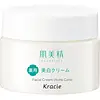What's inside
What's inside
 Key Ingredients
Key Ingredients

 Benefits
Benefits

 Concerns
Concerns

No concerns
 Ingredients Side-by-side
Ingredients Side-by-side

Water
Skin ConditioningPanthenol 10%
Skin ConditioningSqualane
EmollientButylene Glycol
Humectant1,2-Hexanediol
Skin ConditioningNiacinamide
SmoothingBambusa Vulgaris Extract
Skin ConditioningHydrolyzed Jojoba Esters
Skin ConditioningAcrylates/C10-30 Alkyl Acrylate Crosspolymer
Emulsion StabilisingAmmonium Acryloyldimethyltaurate/Vp Copolymer
Hydroxyacetophenone
AntioxidantTromethamine
BufferingDipotassium Glycyrrhizate
HumectantEthylhexylglycerin
Skin ConditioningXanthan Gum
EmulsifyingDisodium EDTA
Sodium Hyaluronate
HumectantMadecassoside
AntioxidantAsiaticoside
AntioxidantAsiatic Acid
Skin ConditioningMadecassic Acid
Skin ConditioningCopper Tripeptide-1
Skin ConditioningWater, Panthenol 10%, Squalane, Butylene Glycol, 1,2-Hexanediol, Niacinamide, Bambusa Vulgaris Extract, Hydrolyzed Jojoba Esters, Acrylates/C10-30 Alkyl Acrylate Crosspolymer, Ammonium Acryloyldimethyltaurate/Vp Copolymer, Hydroxyacetophenone, Tromethamine, Dipotassium Glycyrrhizate, Ethylhexylglycerin, Xanthan Gum, Disodium EDTA, Sodium Hyaluronate, Madecassoside, Asiaticoside, Asiatic Acid, Madecassic Acid, Copper Tripeptide-1
Ascorbyl Glucoside
AntioxidantO-Cymen-5-Ol
AntimicrobialDipotassium Glycyrrhizate
HumectantSoluble Collagen
HumectantAvena Sativa Kernel Extract
AbrasiveHumulus Lupulus Extract
AntimicrobialTartaric Acid
BufferingWool Extract
Skin ConditioningCitrus Limon Fruit Extract
MaskingWater
Skin ConditioningGlycerin
HumectantCyclomethicone
EmollientDipropylene Glycol
HumectantEthyl Glucoside
HumectantPotassium Hydroxide
BufferingHydrogenated Castor Oil
EmollientAmylvinyl Carbinol
PerfumingPEG-Crosspolymer
Alcohol Denat.
AntimicrobialPolysorbate 20
EmulsifyingDimethicone
EmollientPolysilicone-1 Crosspolymer
Skin ConditioningXanthan Gum
EmulsifyingHedta
AbsorbentButylene Glycol
HumectantPhenoxyethanol
PreservativeSodium Paraben
PreservativeParfum
MaskingAscorbyl Glucoside, O-Cymen-5-Ol, Dipotassium Glycyrrhizate, Soluble Collagen, Avena Sativa Kernel Extract, Humulus Lupulus Extract, Tartaric Acid, Wool Extract, Citrus Limon Fruit Extract, Water, Glycerin, Cyclomethicone, Dipropylene Glycol, Ethyl Glucoside, Potassium Hydroxide, Hydrogenated Castor Oil, Amylvinyl Carbinol, PEG-Crosspolymer, Alcohol Denat., Polysorbate 20, Dimethicone, Polysilicone-1 Crosspolymer, Xanthan Gum, Hedta, Butylene Glycol, Phenoxyethanol, Sodium Paraben, Parfum
 Reviews
Reviews

Alternatives
Ingredients Explained
These ingredients are found in both products.
Ingredients higher up in an ingredient list are typically present in a larger amount.
Butylene Glycol (or BG) is used within cosmetic products for a few different reasons:
Overall, Butylene Glycol is a safe and well-rounded ingredient that works well with other ingredients.
Though this ingredient works well with most skin types, some people with sensitive skin may experience a reaction such as allergic rashes, closed comedones, or itchiness.
Learn more about Butylene GlycolDipotassium Glycyrrhizate comes from licorice root.
Extracts of licorice have demonstrated to have antibacterial, anti‐inflammatory, antiviral, antioxidant properties.
One component, glabridin, has extra potent antioxidant and soothing properties. It has also been found to block pigmentation from UVB rays in guinea pigs.
Licorice Root also contains a flavonoid. Flavonoids are a natural substance from in plants. Flavonoids also have antioxidant properties.
Another component, glycyrrhizin, has been found to have anti-inflammatory and antimicrobial benefits. This may make licorice root extract effective at treating acne. However, more research is needed to support this.
Liquiritin is one of the flavone compounds found in licorice. It has been found to help lighten skin by preventing tyrosinase from reacting with tyrosine. When the two react, protein is converted to melanin. Melanin is the substance in your body that gives your features pigmentation.
Licorice root is native to Southern Europe and Asia. It has been used in traditional Chinese medicine to help with respiratory issues.
Learn more about Dipotassium GlycyrrhizateWater. It's the most common cosmetic ingredient of all. You'll usually see it at the top of ingredient lists, meaning that it makes up the largest part of the product.
So why is it so popular? Water most often acts as a solvent - this means that it helps dissolve other ingredients into the formulation.
You'll also recognize water as that liquid we all need to stay alive. If you see this, drink a glass of water. Stay hydrated!
Learn more about WaterXanthan gum is used as a stabilizer and thickener within cosmetic products. It helps give products a sticky, thick feeling - preventing them from being too runny.
On the technical side of things, xanthan gum is a polysaccharide - a combination consisting of multiple sugar molecules bonded together.
Xanthan gum is a pretty common and great ingredient. It is a natural, non-toxic, non-irritating ingredient that is also commonly used in food products.
Learn more about Xanthan Gum